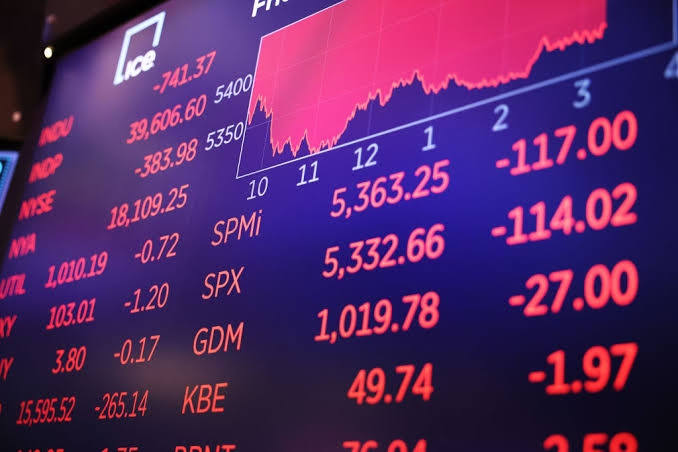In a two-day period, US stock prices experienced a precipitous decline of $5.4 trillion, primarily driven by the apprehension of a recession precipitated by President Trump’s imposition of tariffs. China’s retaliatory measures against Washington’s levies have further exacerbated the global market’s pessimism.
President Trump’s ambitious plan to disrupt the global trading framework through substantial tariffs resulted in a substantial loss of $5.4 trillion in US stock value within a mere two days. China responded by imposing its own levies, heightening global concerns regarding the potential emergence of a recession.
The S&P 500 index experienced a notable decline of 6% on Friday, following a 4.8% drop the preceding day. This decline led to a substantial loss of $5.38 trillion in market value, as determined by Financial Times based on FactSet data. The underlying cause of this market turmoil can be traced back to President Trump’s announcement on Wednesday, which was dubbed “liberation day.”
The blue-chip index experienced a significant 9.1% decline over the past week, representing the most substantial drop since the commencement of the pandemic five years ago.
Technological stocks, encompassing prominent entities such as Apple and Amazon, suffered losses, causing the Nasdaq Composite to plummet more than 20% from its peak in mid-December. This decline propelled the gauge into the “bear market” category. In contrast, Europe’s Stoxx 600 experienced a 8.4% decline, while the UK’s FTSE 100 fell by 7%. The MSCI Asia index also recorded a 4.5% decline.
The current turmoil underscores the impact of President Trump’s plans to implement a 10% universal tariff and impose substantial “reciprocal” duties on numerous countries within a short timeframe. These actions have eroded investor confidence and engendered apprehensions about a potential slowdown in the world’s largest economy.
On Friday, China, the world’s largest exporter, further intensified the gloom by announcing duties of 34% on all US imports.
Ajay Rajadhyaksha, the global chair of research at Barclays, cautioned that if the reciprocal tariffs are not reversed by April 9, which he does not anticipate will occur, the United States and the European Union are likely to face a recession. He emphasized the urgent need for a prompt resolution to the global trade conflict, as he predicts a US recession this year unless there is a substantial change in the situation.
Federal Reserve Chair Jay Powell also issued a warning on Friday, stating that Trump’s tariffs would result in higher inflation and slower economic growth.
Powell acknowledged that the tariff increases are significantly larger than anticipated, and he believes the economic consequences will likely be equally substantial.
Prior to Powell’s speech, Trump had requested that the Federal Reserve chief lower borrowing costs. He expressed his belief that this would be an ideal time to reduce interest rates on his social media platform.
He also mentioned that China had “PANICKED — THE ONE THING THEY CANNOT AFFORD TO DO,” referring to Beijing’s plan to retaliate against US tariffs with steep duties of their own.
However, the remarks from the US president did little to alleviate equity markets, which are already experiencing heightened concerns about a further deterioration in the economic outlook.
In response, JPMorgan, a prominent Wall Street bank, downgraded its forecast for the US economy on Friday. They now anticipate a decline in output of 0.3% in 2025, on a quarterly-over-quarterly basis, compared to their previous estimate of a 1.3% expansion.
Furthermore, the Wall Street bank added that the projected recession in economic activity is expected to lead to an increase in the unemployment rate to 5.3%.
Citigroup, like many other financial institutions, has revised its US growth target for 2025 downwards. Previously, the target was set at 0.6%, but now it stands at a mere 0.1%.
Citi attributes this downward revision to the unprecedented uncertainty surrounding the US economic outlook. The company emphasizes that a modern developed economy has never experienced such significant and rapid increases in tariffs.
This bearish sentiment contrasts sharply with the strong employment report released on Friday morning. The report revealed that the US added more jobs than anticipated, and the jobless rate remained at a relatively low 4.2%.
The market’s anxiety is evident in the exodus of investors from lowly rated US corporate bonds and other risky assets. Instead, they are seeking refuge in safer havens such as Treasury bonds.
The sell-off intensified as banks faced pressure from hedge fund clients to provide additional capital. This pressure arose due to the market turbulence that has affected their portfolios. Moreover, several companies, including fintech company Klarna, have halted plans for initial public offerings (IPOs).
The Vix index, a widely used indicator of expected volatility in US stocks often referred to as Wall Street’s “fear gauge,” experienced a notable surge. It rose by 15.1 points to reach a record high of 45.1, the highest level since 2020.
The rout extended to commodity markets, with international oil benchmark Brent experiencing a 6.5% decline on Friday, reaching a settlement of $65.58 per barrel, its lowest point in three years. US oil marker WTI also fell by 7.4% on the same day, settling at $61.99 per barrel, below the price many shale producers require to break even.
The price of copper, often regarded as a proxy for traders’ assessment of the health of the global industry, declined by approximately 9% in the UK evening.
US Treasury bonds have emerged as the primary beneficiaries of the stock sell-off, with the 10-year Treasury yield—a rate closely linked to growth expectations—falling to 3.86%, its lowest level since before Trump’s election.

Leave a Reply